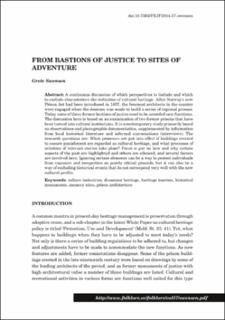| dc.description.abstract | A continuous discussion of which perspectives to include and which to exclude characterises the definition of cultural heritage. After Norway’s new Prison Act had been introduced in 1857, the foremost architects in the country were engaged when the decision was made to build a series of regional prisons. Today some of these former bastions of justice need to be accorded new functions. The discussion here is based on an examination of two former prisons that have been turned into cultural institutions. It is a contemporary study primarily based on observations and photographic documentation, supplemented by information from local historical literature and informal conversations (interviews). The research questions are: What processes are put into effect if buildings erected to ensure punishment are regarded as cultural heritage, and what processes of selection of relevant stories take place? Focus is put on how and why certain aspects of the past are highlighted and others are silenced, and several factors are involved here. Ignoring certain elements can be a way to protect individuals from exposure and recognition on purely ethical grounds, but it can also be a way of excluding historical events that do not correspond very well with the new cultural profile. | en_US |
